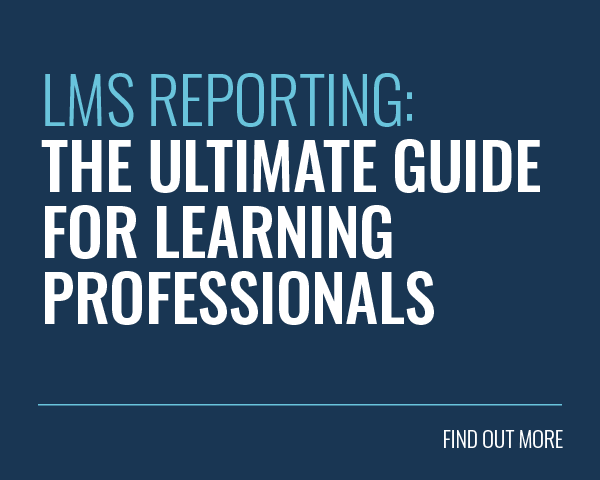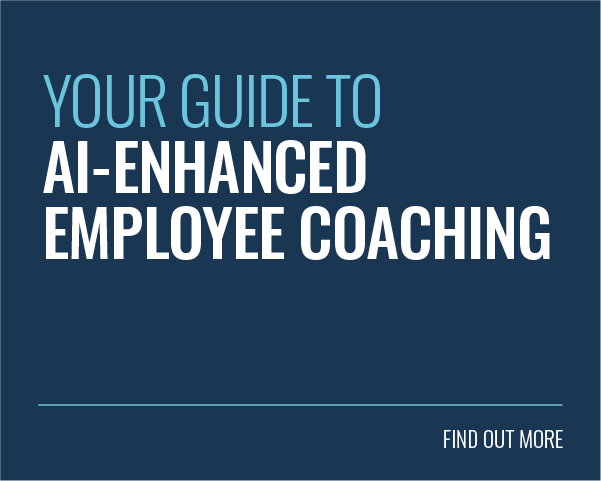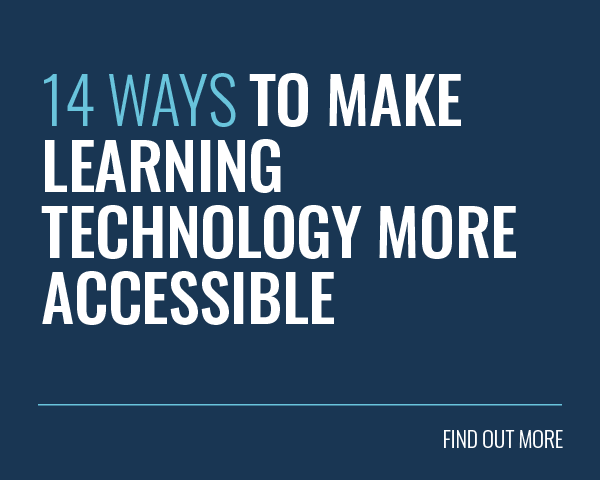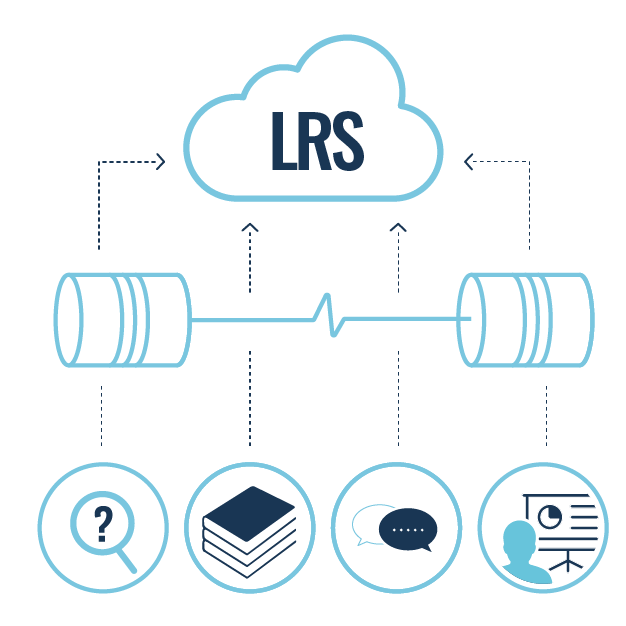
If you’ve used learning technology before, you’ve probably come across the term LRS. Yes, that’s right. Another acronym to add to our never-ending list of online learning terminology. But what does it mean?
LRS stands for Learning Record Store. And contrary to what you might think, it’s not somewhere you go to pick up new vinyl records.
LRSs were developed to make storing and transferring learning data easier. They’re literally an application that ‘stores’ learning records. Consider it your very own virtual storage cabinet!
In this article, we’ll take a look at LRSs in fine detail. You’ll learn why they’re so important for learning tech, their benefits and more. Let’s get going!
A Brief Introduction to SCORM and xAPI
A few things need to be clarified before we dive into the true meaning of an LRS.
SCORM
Let’s start with SCORM. SCORM stands for Shareable Content Object Reference Model.
‘Shareable Content Objects’ are your learning content. This content can be shared and reused across different systems.
For this to work, it will need to follow the ‘Reference Model’. This model provides a list of technical specifications that your content must achieve for it to be SCORM-compliant. If you meet this criteria, then finding a matching system to host and deliver it will be a cinch.
SCORM has been the eLearning industry’s ‘it girl’ for a while and still is. However as modern technology progresses, so do industry standards. Hence, the birth of xAPI.
xAPI
At the start of the 2010s, intrepid researchers began to seek out alternatives for SCORM.
After an intensive period of research and development, the first iteration of xAPI was introduced in 2013. Since then, xAPI has been used with Learning Management Systems (LMS) to elevate the user experience and track all types of learning events.
Unlike SCORM, xAPI can capture learning that happens outside of an LMS. This enables it to record informal training experiences. This matters, as social learning and learning by experience is said to make up 90% of all knowledge intake.
xAPI collects data in the form of ‘noun, verb, object’. This ends up looking like ‘I did this’. For example, it translates into ‘Jenny read a training manual’ or ‘John watched a training video’.
An LMS wouldn’t be able to accept this data on its own. As such, the Learning Record Store was developed and introduced alongside xAPI to store the data it receives from them.
What is an LRS?
It’s important to note that the LRS does not replace the LMS. It only stores and reports on information. It can’t deliver eLearning, manage learners or any of the other amazing things an LMS can do.
As Josh Bersin states, an LRS is the ‘atomic database’ of information that stores the detailed ‘clickstream’ of learning. It captures every learning activity — down to the smallest click. As you’d expect, this granularity enables in depth reporting and better data insights. What’s not to love?
With an LRS, you also can transfer data to other systems. All systems that send data to an LRS are known as an ‘Activity Provider.’ This could include an LMS, LXP, a content system, a talent management system, assessment tools and so on. The possibilities are endless.
The LRS sits at the centre of this learning universe. It collects, it stores and it distributes.
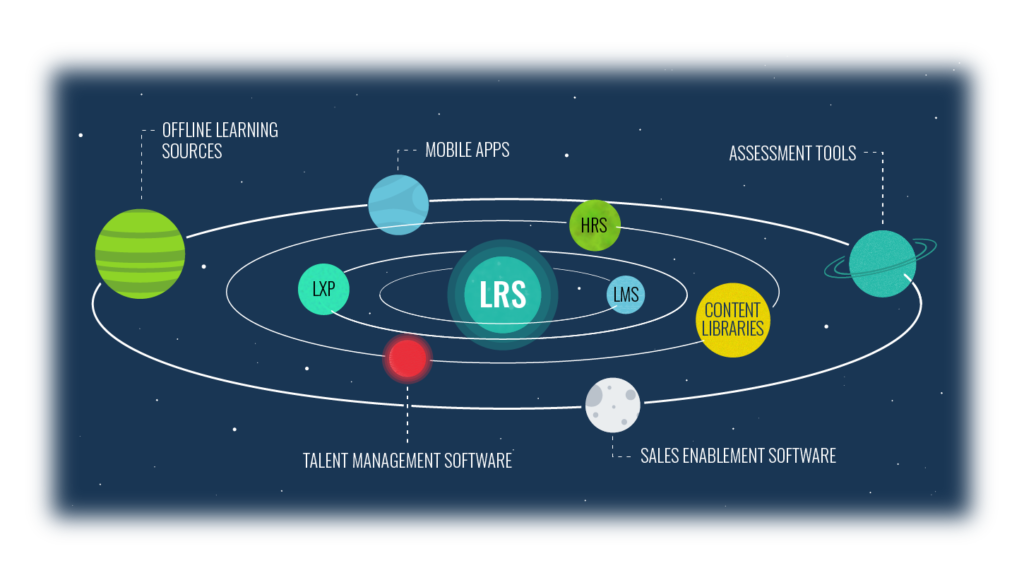
Types of LRSs
An LRS can be classed into three different categories:
1. Learning Analytics Platforms
These pull learning and performance data from a variety of places. This data is then analysed in order to provide you with insights to help you make strategic improvements to your learning programme.
2. Integratable LRSs
As the name suggests, these platforms were created to integrate with other applications, like an LMS. This grants the application all the benefits that arise from LRS functionality.
3. Testing and Development LRSs
These LRSs provide developers that work with xAPI with detailed debugging information. This helps them to fix any technical issues that may be holding your learning programmes back.
You can build an LRS into an LMS to upgrade its reporting functionality, or you could host your LRS externally. However, it must adhere to xAPI standards otherwise you’ll encounter problems when you try to integrate your LRS with other systems.
On that note, let’s take a look at the relationship between xAPI and an LRS.
How LRSs Store Information via xAPI
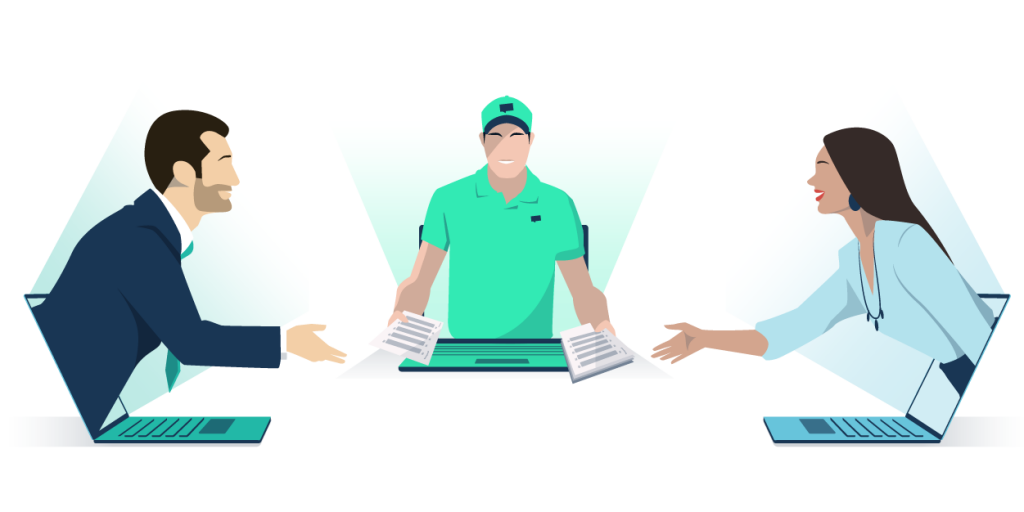
xAPI is essentially a combination of four REST (REpresentational State Transfer) APIs. They’re the most popular type of APIs in learning tech and actually make up 70% of public APIs.
These four APIs include one Statement API and three types of Document APIs: State, Activity and Agent.
Here’s a rundown of each one:
1. A Statement API
From the name you might be able to guess what this one’s all about. A Statement API focuses on how you input a statement into an LRS or transfer statements into another system.
But what’s a statement? Put simply, they are the ‘noun, verb, object’ structure that we mentioned above! They are a summary of the learning activities that have been completed.
2. A State API
This is a ‘holding space’ where you can save learning activities in progress. For example, a person could be editing text as a learning activity. They can store the text in an LRS with a state API. Then, when they’re ready, they can pick back up where they left off!
In other words, this API stores the ‘state’ of a relationship between the learner and a learning activity.
As you might expect, this API stores activity data in your LRS. Your LRS will receive this data and decide on the best way to describe it to you.
In addition, with this API you can store actions that don’t relate to one specific learner. For example, on Growth Engineering LMS we use social learning and gamification to create an engaging learning environment.
3. An Activity API
With the Activity API, interaction between learners is collated much more efficiently. It does this by storing scores across users in the LRS as a document for the activity.
Leaderboards, for example, are populated a lot quicker this way.
4. An Agent API
Lastly, we have the Agent API. This API is similar to the State and Activity APIs but has a slightly different purpose. It adds extra data to the LRS about individual learners (i.e. ‘agents’). Specifically, it helps an LRS to identify users by assigning them a unique ID.
It’s all quite technical, but the idea behind it is quite simple. An LRS is really just a huge database. With the help of xAPI (underpinned by the four APIs above), they store user points of contact on your learning solution.
Benefits of an LRS
LRSs come with many advantages which is why they’re so widely used. Let’s go through a few of the benefits!
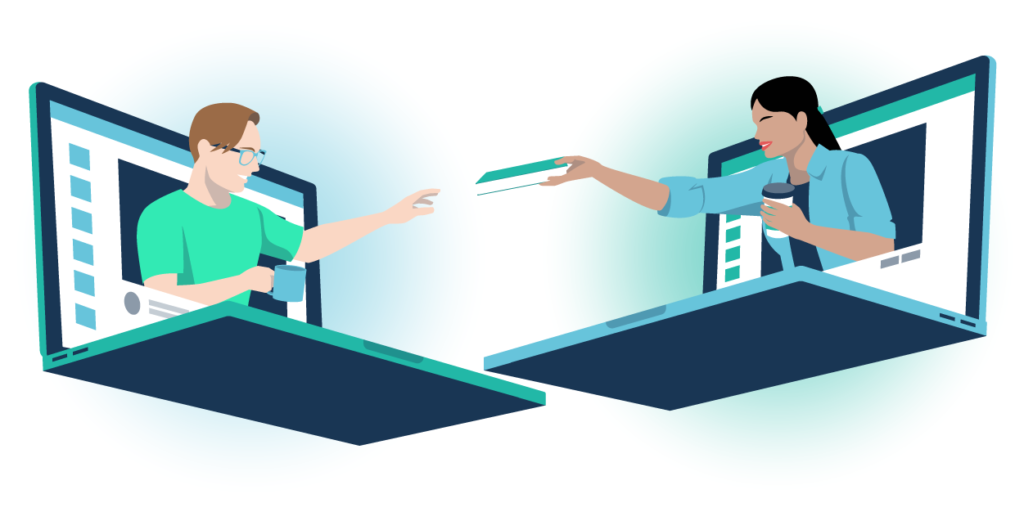
1. Wider Reach
Traditionally, an LMS has only been able to report on very limited data. For example, it will typically track whether an eLearning unit has been completed or not, and what score the learner achieved.
However, 90% of learning is informal and takes place outside of such formal training processes.
Because it’s designed to work with xAPI, an LRS is able to store all of the experiences that take place outside of formal learning. This includes social learning which accounts for 20% of knowledge intake (and has been shown to boost memory retention).
With an LRS, you can now report on the full scope of all learning activities that your team will undertake. Whether that’s completing an eLearning unit, liking a social post or having a one-to-one with a manager.
Ultimately, you end up with a more comprehensive overview of learner progress.
2. Data that Travels with You
While an LMS can store and report on eLearning data, its records only go back to the point when the learner started using the system.
Additionally, this data isn’t portable. Once the learner completes their training, there typically isn’t any way for them to take their records with them.
An LRS is designed to make this data accessible. Information can be added to it, but it can also be exported. A learner could potentially have their own personal data locker, as well as their company’s LRS. This way they can take their learning records with them when they start a new job.
This would give their new employer a clear idea of all of the training they’ve done so far, allowing them to tailor a development programme to suit them.
Demonstrating that you care about employee development is vital. LinkedIn found that 94% of employees say that they’d stay longer at a company if they are given the opportunity to learn!
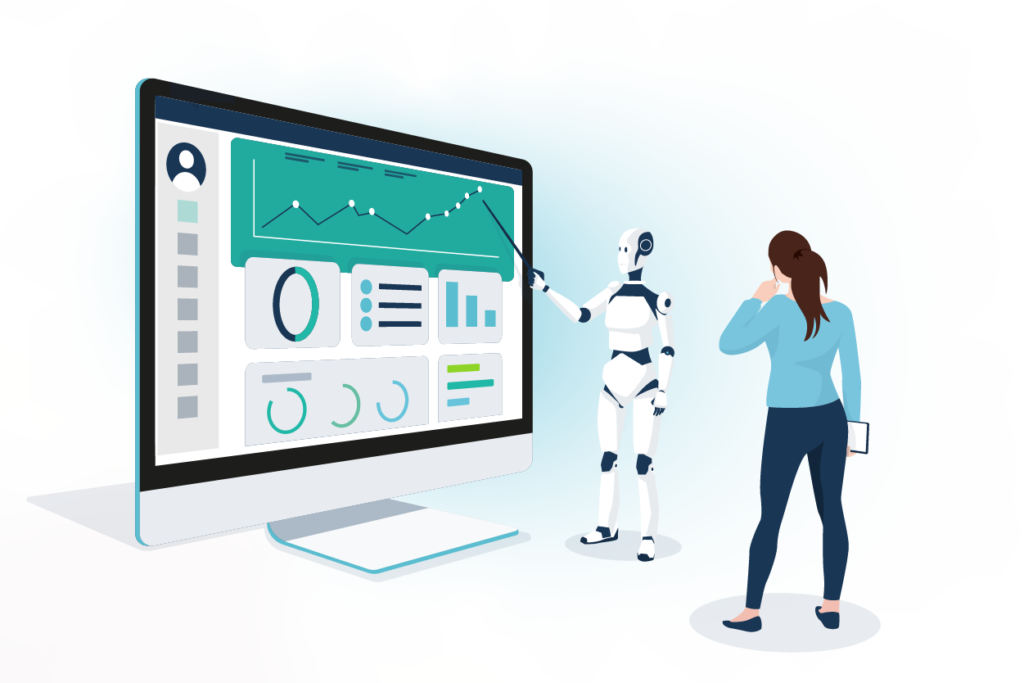
3. Correlation with Performance
Thanks to the ‘noun, verb, object’ approach to recording data, just about any action can be recorded. This means that ‘Stevie completed an eLearning unit’ can now be placed alongside ‘Stevie increased sales by 50%’.
With all of this information in one place, it becomes possible to spot patterns in how effective particular training strategies are.
You can then look at what content your best performing employees have completed and use it to tweak future training initiatives.
Furthermore, this should make it easier than ever to prove the return on investment of your training programme. This is important, as 81% of L&D teams say that they experience barriers when evaluating their initiatives.
With an LRS, you have all the data you need to start making better decisions. Hurrah!
4. Keep Track of Offline Learning
As we’ve seen, LRSs can store data from a variety of sources. They are able to capture both formal and informal learning experiences. Furthermore, they are also able to record learning experiences that take place offline.
This gives them a big advantage over traditional LMS reporting, as it provides a broader survey of learners’ experiences. In turn, this means that nothing gets lost.
As mobile learning continues to grow in popularity, much of our learning now happens on the go. We use a variety of different devices to access a variety of different training experiences. An LRS grants learners the opportunity to record all of these experiences, regardless of where they took place.
Finally, thanks to LRS and xAPI technology, online / offline content sync is now possible. Solutions like Growth Engineering Learning App enable learners to complete content offline and sync the results up once they are reconnected. It’s just like magic!
Do You Need an LRS?
While an LRS has many advantages, it may not be for everyone. Before diving in, you should consider your needs and your budget.
LRSs are only really necessary if you have a large amount of data to store. Smaller organisations may consider this to be an unnecessary investment.
Likewise, organisations with streamlined learning and development operations might not need an LRS. If all your learning is managed on a single platform (such as an LMS), then you won’t need a separate central repository for your learning data.
Similarly, perhaps informal learning isn’t a big focus for you as an organisation. If this is the case, then you may not need an LRS at this stage.
However, for many companies, LRSs are moving from being a ‘nice to have’ to being a hard and fast requirement. After all, organisations spend an average of $1,111 per employee on training each year. It’s only natural that L&D departments want to ensure they’re getting bang for their buck!
Final Words
The LRS was created to support your training initiatives by collating, storing and distributing learning data. It was designed with that purpose back in 2013, and that purpose remains the same today.
With an LRS, all learner actions can be tracked and stored. Formal and informal. Online and offline. Mobile and desktop. Because of the simple nature of xAPI statements, there’s nothing that can’t be recorded.
As we’ve seen, having all this data together in one place helps you to make better decisions about your training programme. There are advantages for your learners as well, as LRSs unshackle learning data and make it easy to transfer across different systems.
As the number of different learning systems and sources grow, Learning Record Stores will become increasingly important. If you struggle to collect, maintain and analyse your learning data, then an LRS could be exactly what you need!
At Growth Engineering, we provide a full suite of learning solutions, backed by a Learning Record Store. We’re also learner engagement experts. Get in contact with us today to learn more.


